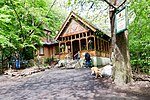New London Performing Arts Centre
The New London Performing Arts Centre (NLPAC) is a performing arts school in Muswell Hill, North London, founded in 1995 by Emily Byron. With 20 years of experience, NLPAC is an ISTD Approved Dance Centre and is registered by Ofsted and the CDET. NLPAC is a registered charity and all profits go back into providing high quality and affordable classes consisting of Ballet, Tap, Modern contemporary, Street Dance and jazz, and Drama. Pupils range from 3 onwards to 19. The centre also runs Stage School which offers students a chance to learn all three disciplines of performing arts in one 2 hour session. Students will take 40 minutes of drama, dance and singing. As well as these the centre has private singing and musical lessons offering one-to-one training in a wide range of musical instruments. Students can choose to further go on and take an exam with NLPAC being an ABRSM and Trinity music examination centre. They also offer holiday workshops throughout school holidays. Classes on offer include: ISTD and RAD Ballet, ISTD Tap and Modern, Contemporary, Jazz, Street Dance, Hip Hop, Break Dance, Musical Theatre, LAMDA Exams, Drama classes, Private singing and music lessons following the ABRSM and Trinity Guildhall syllabus Students from the performing arts school have gone on to perform in every West End musical starring children actors, including Charlie and the Chocolate factory, Billy Elliot, Matilda and Les Misérables. In addition to this, they have starred in films such as Harry Potter and televised series such as Holby City and EastEnders.
Excerpt from the Wikipedia article New London Performing Arts Centre (License: CC BY-SA 3.0, Authors).New London Performing Arts Centre
St James's Lane, London Muswell Hill (London Borough of Haringey)
Geographical coordinates (GPS) Address Nearby Places Show on map
Geographical coordinates (GPS)
| Latitude | Longitude |
|---|---|
| N 51.5882 ° | E -0.1396 ° |
Address
North London Performing Arts College
St James's Lane
N10 3RG London, Muswell Hill (London Borough of Haringey)
England, United Kingdom
Open on Google Maps











